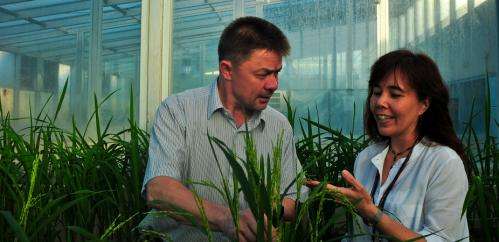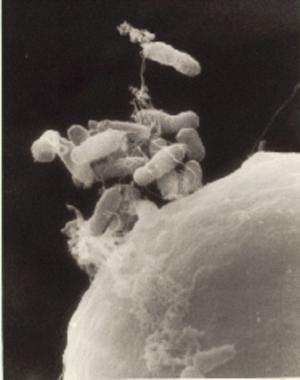GM techniques: from the field to the laboratory (and back again)

Genetic modification (GM) sounds very laboratory-based – people in white coats inserting and deleting genes – but the vast majority of GM work was completed in the field through selective breeding.
Early Middle Eastern farmers collected grain from natural grasslands, but they needed to time their harvest very carefully. If they were too early the grain wouldn't store well, and if they were too late the grain would spread over the ground making collection difficult.
At some stage, one of these early farmers must have noticed that some heads remained fixed on their stems even after the grain was fully dry. He obviously didn't understand this at the time, but these were plants with a mutation in the genes controlling seed dispersal.
Farmers began preferentially choosing plants with this useful mutation and planting them, perhaps the first case of breeding and selecting for a novel trait.
Exploiting genetic variation
Systematic breeding really began in the early 1900s when scientists rediscovered Silesian monk Gregor Mendel's groundbreaking work on genetic inheritance in peas.
Breeding involves utilising genetic variation to produce new combinations of genes and gene variants. A breeder will cross two different lines and then select offspring that have improved performance.
Breeders are always looking for new sources of variation, normally from within the elite germplasm pool – that is, within established varieties. Many important traits, such as disease resistance, are controlled by single genes and can be crossed into elite lines, with only the resistant offspring selected.
But for many crops the level of diversity available within the elite germplasm pool is very narrow and breeders must look further afield for novel variation. This search led breeders to explore land races (varieties grown by traditional farmers) and even wild relatives (undomesticated progenitors of our modern crops).
In many cases crosses between the wild relatives and modern lines will not produce normal seeds, but the embryos can often be isolated from the developing seed and grown in sterile tissue culture to produce viable, fertile plants.
This technique, called embryo rescue, has been widely used and many modern cultivars contain genes from wild relatives.
The normal number of genes present in a crop plant is around 30,000 to 40,000 – the same as for humans. In making the crosses all 30,000 genes from the wild relative are introduced but the breeder may only want one gene.
The genes are linked along chromosomes with each chromosome carrying several thousand genes. The breeders need to break up the chromosomes from the wild relative into small fragments so that only the desired region is transferred – a process called chromosome engineering.
This can take several decades of work, making the use of wide crosses technically difficult and slow. Breeders want other methods of generating useful variation.
Engineering mutations
In the 1950s the idea of inducing mutations became an important technique for creating new variation. This involved using ionising radiation, such as X or gamma rays, or chemical mutagens.
These techniques produce random damage to the genetic information in the plant by changing the DNA directly or knocking out segments of the genome (the genetic make-up). Most mutations are deleterious, and the mutagenesis usually generates many thousands of unwanted changes, so the clean-up can be slow.
After exposing the plants to the mutagen, the breeders need to select for the beneficial mutations and remove the deleterious mutations.
Scientifically the ideal solution would be to be able to take a gene from any source and introduce it into your crop plant to change the plant's characteristics. This would allow breeders to use variation from diverse sources and make changes just one gene at a time without the extensive collateral damage done by mutagenesis or wide crosses. This is what genetic engineering offers.
Enter the lab coats …
The first genetically engineered crops were produced in the 1980s and, as in all areas of science, the technology continues to advance. The most widely used method today takes advantage of a natural DNA transfer mechanism.
Several groups of soil bacteria are able to engineer plants for their own benefit. These bacteria transfer a segment of their genome into the plant's genome so that the transformed plant cells will proliferate and produce compounds that only the bacteria can use. In this way the bacteria control the plant development to produce nutrients for the bacteria.
The mechanisms for this type of natural genetic engineering are now well understood, allowing scientists to change the DNA segment transferred so that the genes causing altered plant growth are removed and new genes inserted.
How does this work practically? In a laboratory the scientist will design and build a DNA sequence containing specific sequences that delineate the region of DNA to be transferred (the left and right borders). They then insert the gene of interest and usually a selectable marker, such as resistance to a herbicide.
This construct is then introduced into a bacteria called Agrobacterium tumefaciens, which readily takes up DNA. The bacteria are then applied to growing plant tissues in sterile culture.
After a period the bacteria are removed and the plant tissues placed onto media containing the herbicide. Only the plant cells that have been transformed (those that took up the construct from the bacterium) are able to grow and divide.
These cells are allowed to multiply and divide until they produce plants, which are taken out of sterile culture to a glasshouse where they can grow to maturity. The genes that have been transferred will now be included in the genetic make-up of the plant.

Different species and even varieties will differ in their ability to take up DNA from the bacterium and to regenerate normal plants. Where in the genome the new DNA inserts is usually random but will preferentially occur in regions containing active genes.
Extensive growth trials and evaluation are needed to ensure that the transgenic or genetically engineered plant behaves as expected.
… and back to the field
In Australia all aspects of genetic engineering research are closely regulated. The researcher, organisation and facilities used must all be licensed and meet tight standards.
Before a field trial can be grown, the Office of the Gene Technology Regulator (OGTR) conducts a detailed risk assessment of the genes used, the reasons for the trial, and the design and management of the trial site.
The OGTR have issued 103 licenses for field trials covering 14 different crops. In Australia 37 genetically engineered crops have been approved for commercial cultivation for seven different species, but only GM cotton (eight different events) and canola (three events) are grown to any great extent.
The resistance to GM crops in many parts of the world has encouraged scientists to look for alternative techniques for making targeted changes to the genetic make-up of crops and other organisms.
For example, a new technique called "genome editing" allows us to make specific changes to native genes within the plant that are essentially identical to the changes induced by mutagenesis but at only one site rather than all over the genome. Mutagenesis is widely used and is not subject to regulation – will the same apply to genome editing?
There are other developments that are also challenging the community's views on new technologies. How will people feel about GM crops where a native gene has been isolated, changed and re-inserted (a process known as cisgenics)?
What about using GM rootstocks engineered for resistance to root diseases, but grafted with non-GM scion so that they produce non-GM apples or avocados?
These questions are now challenging the regulators since the first examples are starting to become available.
Source: The Conversation
This story is published courtesy of The Conversation (under Creative Commons-Attribution/No derivatives).
![]()




















